Armley Jail – A History of the Town and the Prison
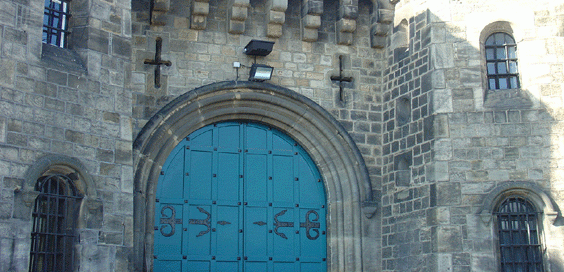
Keith Spence looks back at the grim history of one of the country’s most notorious prisons and asks whether the town has now been given a reprieve from its life sentence…
The grim and forbidding facade of the notorious Victorian jail has dominated the skyline of the proud town of Armley for over 160-years. Its presence spreads an air of notoriety through a town which across the years has grittily got on with its business and has a proud and fascinating industrial history with its clanking mills and bustling factories. Now that Armley’s raison d-etre – the industrial revolution – has been consigned to the history books, is a new window of opportunity about to open? Having failed to live up to its potential, is there a chance that things are now about to change for the town?
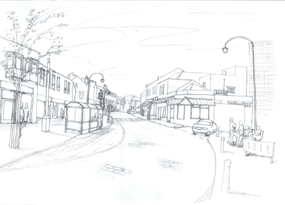 Within minutes of the thriving centre of Leeds, until a few years ago Armley boasted an excellent shopping centre with a fine collection of butchers, bakers, fruiterers and a mixture of multiples. You could park on or near Town Street and do your week’s shopping in an hour, bobbing from one shop to another with a basket which would include a fine selection of local produce.
Within minutes of the thriving centre of Leeds, until a few years ago Armley boasted an excellent shopping centre with a fine collection of butchers, bakers, fruiterers and a mixture of multiples. You could park on or near Town Street and do your week’s shopping in an hour, bobbing from one shop to another with a basket which would include a fine selection of local produce.
“Ideas for a public mural”
Now, sadly, Town Street is a shadow of its former self, run down and rather shabby with a hang-dog look. Family businesses have disappeared, butchers have been replaced by bookies, an amusement arcade is next door but one to a smart solicitors’ front office with the sign “Can we help? No appointments needed”. Handy if you’ve hit hard times amusing yourself. In fact the area now has three bookmakers, two amusement arcades and a pawnbrokers. Opposite is a narrow street called “The Gang” while round the corner is Armley Fashions, specialists in hairdressing and hospital garments. But is all this about to change?
A one and a quarter million pound Townscape Heritage funding project for Town Street is planned which is hoped will revitalise the area and make shopping once more a pleasurable expedition. Life will come back to Town Street with new jazzy pavements and flats above the single-storey shops; there will be wine bars and coffee shops. Derelict buildings will be improved and shops given a facelift in the biggest plan for any area in Leeds. There are even ideas for a public mural depicting scenes from Armley’s history.
“Employs a lot of local labour”
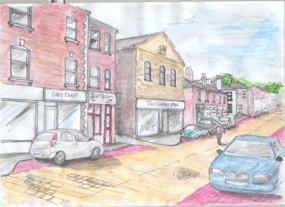 Armley councillor James McKenna believes this will help to transform Armley, together with other improvements, such as the transformation of the derelict Winkers Mill into flats, wine bar and water features. “We hope this will kick-start the town centre with new restaurants opening and possibly a Starbucks,” says the councillor. The town itself has a lot going for it. Although renowned for its notorious asbestos scandal, there are the fine open spaces of Armley Moor. The moor is the only common rights land in Leeds, safeguarded with a charter from King Charles. The vast expanse of Armley Park provides a refreshing backdrop.
Armley councillor James McKenna believes this will help to transform Armley, together with other improvements, such as the transformation of the derelict Winkers Mill into flats, wine bar and water features. “We hope this will kick-start the town centre with new restaurants opening and possibly a Starbucks,” says the councillor. The town itself has a lot going for it. Although renowned for its notorious asbestos scandal, there are the fine open spaces of Armley Moor. The moor is the only common rights land in Leeds, safeguarded with a charter from King Charles. The vast expanse of Armley Park provides a refreshing backdrop.
As other towns have smartened their act, Armley has been left behind. At the height of the property boom it was regarded as “the next best thing“, “up and coming“, and the “latest hotspot” whenever the place was mentioned in property circles. Well, it’s been slow to happen. The yuppies have stayed away, the property investors have gone elsewhere and the town has languished. The centre has been allowed to deteriorate. Now more is going to be done to attract younger residents. Surely, if it was good enough in the past for the likes of Alan Bennett and Barbara Taylor Bradford, there must be hope for the future.
“Community spirit”
Councillor McKenna wouldn’t live anywhere else. “Armley’s got a lot going for it. When the housing market gets back on song it will take off. It’s got the best medical centre in Leeds and they’re building a new high school. All is not lost – in fact it’s good news. There’s a great community spirit with 70 people regularly attending our monthly forums when plans for Armley’s future are discussed.”
He says there is plenty of work in Armley, but much of it is low paid. There’s a fair share of asylum seekers and plenty of Poles and East Europeans. They are big assets to the community, working on the buses, and in the building trade. He doesn’t feel the prison image drags the area down. Although he feels they’d have a job to persuade the community to let them build one there now, although it employs a lot of local labour.
In fact, Armley was a very special place for anyone brought up there and brings back nostalgic memories. Many couldn’t get away from the close proximity of the prison. In fact those who went to school in Armley recall that the back wall of the school was the back wall of Armley jail. Not everyone enjoys life in the prison, of course, but Malcolm Wright, an officer for 30 years, certainly did. “It was very interesting. You never knew what you would be doing from one day to the next.”
He says overcrowding comes in for criticism from outsiders but has never known a prisoner complain. “Prisoners don’t like to be alone. They’re far happier with two or three in a cell. Some don’t like to be on their own at night and I’ve often been asked if someone could be moved in to keep them company.”
“Rope snapped”
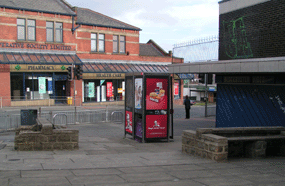 The prison cost £43,000 to build in 1847. The extension in 1993 was £6m and now a £16m refurbishment of a wing is complete. Many of Armley’s scholars would have had sleepless nights if they had known about the grisly tales of past hangings that went on over the wall that adjoined their school. There were 93, including one woman, Emily Swann from Wombwell. Convicted at Leeds Assizes on December 9, 1903, for assisting former lodger John Gallagher in the killing of her husband, William. Apparently the two greeted each other on the scaffold with a “Good morning, love” before the executioner put white hoods over their heads and sent them to their deaths.
The prison cost £43,000 to build in 1847. The extension in 1993 was £6m and now a £16m refurbishment of a wing is complete. Many of Armley’s scholars would have had sleepless nights if they had known about the grisly tales of past hangings that went on over the wall that adjoined their school. There were 93, including one woman, Emily Swann from Wombwell. Convicted at Leeds Assizes on December 9, 1903, for assisting former lodger John Gallagher in the killing of her husband, William. Apparently the two greeted each other on the scaffold with a “Good morning, love” before the executioner put white hoods over their heads and sent them to their deaths.
One prisoner was hanged twice. John Henry Johnson from Bradford was convicted at Leeds Assizes in 1877 for shooting a man. The executioner put a white bag over his head and pulled the lever. The trap door opened but the rope snapped. He was uninjured but ten minutes later he was hanged again. The rope held but his body wasn’t motionless until five minutes after he was sent to his death.
Many of the hangings were of jealous men who had murdered their wives or girlfriends because they were unfaithful. Although one concerned a Harrogate car dealer, Robert Moore, 36, who had a row with another car dealer from Leeds, a married man called Edward Watson. Watson ended up in a shallow grave near Swinsty Reservoir after being shot. Moore tried to gas himself but didn’t have a shilling for the gas meter. He went next door where he wouldn’t need money for the meter. But the owner came home and found him. After being discharged from hospital he took the police to the grave where they found Watson. He was hanged on January 5, 1954.
The last execution to be carried out at Armley Jail was that of a Hungarian man called Zsiga Pankotai. He was caught burgling the home of a market trader, Jack Myers, off Street Lane in Roundhay. Myers was knifed and the killer was later found with a large quantity of clothing he had stolen. The execution was carried out on June 29, 1961.
“The son of a lion tamer”
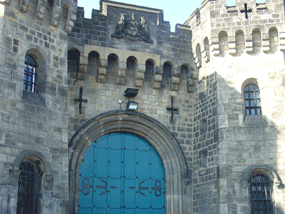 However, the most notorious prisoner to lose his life at Leeds might be the infamous Charles “Charlie” Peace, in February 1879. The son of a lion tamer, he led a riot at Portland Prison. He got the cat-o-nine-tails, was sent to penal reform on a prison hulk in Gibraltar, later shot someone in Sheffield for annoying his wife, and escaped from a train by leaping headfirst out of the window while being transferred to Leeds.
However, the most notorious prisoner to lose his life at Leeds might be the infamous Charles “Charlie” Peace, in February 1879. The son of a lion tamer, he led a riot at Portland Prison. He got the cat-o-nine-tails, was sent to penal reform on a prison hulk in Gibraltar, later shot someone in Sheffield for annoying his wife, and escaped from a train by leaping headfirst out of the window while being transferred to Leeds.
He was caught, sentenced to death and while awaiting trial confessed to killing a policeman. The man who had been given a life sentence for the murder of the policeman was then released. When he was taken to the gallows, Peace told the executioner: “Stop a minute.”
He then said: “Amen, God have mercy on me.”
He told reporters watching of the wicked life he had led, ending with: “ Heaven bless you all. Goodbye, Amen”.
‘Armley Gaol 1864 to 1961 The Execution Era’, costing £7 (including p&p), is available from Malcolm Wright, 35 Leadwell Lane, Rothwell, Leeds LS26 0SR










A fascinating tale. Kindest Regards, Keith Nick
My great-gran’s trial and case is to be explored on next year’s Murder Mystery and My Family with a book about her life and my own – and how they connected ‘Sins of the Family’ have done very well. I dearly would like to have her exhumed and given a proper christian burial – this I am looking into.
My great, great grandfather Abraham Crowther worked as a warden at Armley prison. He was one of the first staff to work there. If anybody as any more information about him I would be grateful.
MY RELATION WAS THE FIRST WARDEN WHEN ARMLEY PRISON WAS OPENED…HE LIVED IN ARMLEY.
Hello to the two mentioning wardens at Armley Jail. I have an old family album. They lived at Armley. Many photos I do not know who they are. However there is one of a jailer with a big bunch of keys. I tend to think he was not family, but maybe neighbour. Would you recognise your relative?
Can I make a comment about the last man to be hung at armley prison a hungerian your report says I various things I disagree with because when I was young I was no Angel and was being booked into leeds bridewell .when I was stood at the booking in desk stood at my side was the last man to be hung in armley the Hungarian I never forget a face but can’t remember names..If my memory serves me well the tale goes a friend of the Hungarian told him the murderd man was a well off market trader who kept money in his house so he went to rob him but Mr Myers came home so he beat Myers to death .then stole some clothing(jeans)and offerd to sell them to a chap in the pub in leeds market called the market hotel (regulars called it the madhouse)but the chap he asked thought he would be able to sell them on to Mr Myers and discovered the poor chap dead I also thought the year was 1962. best regards Walt ps please excuse my spelling
my hubby was in armley jail when that hanging took place